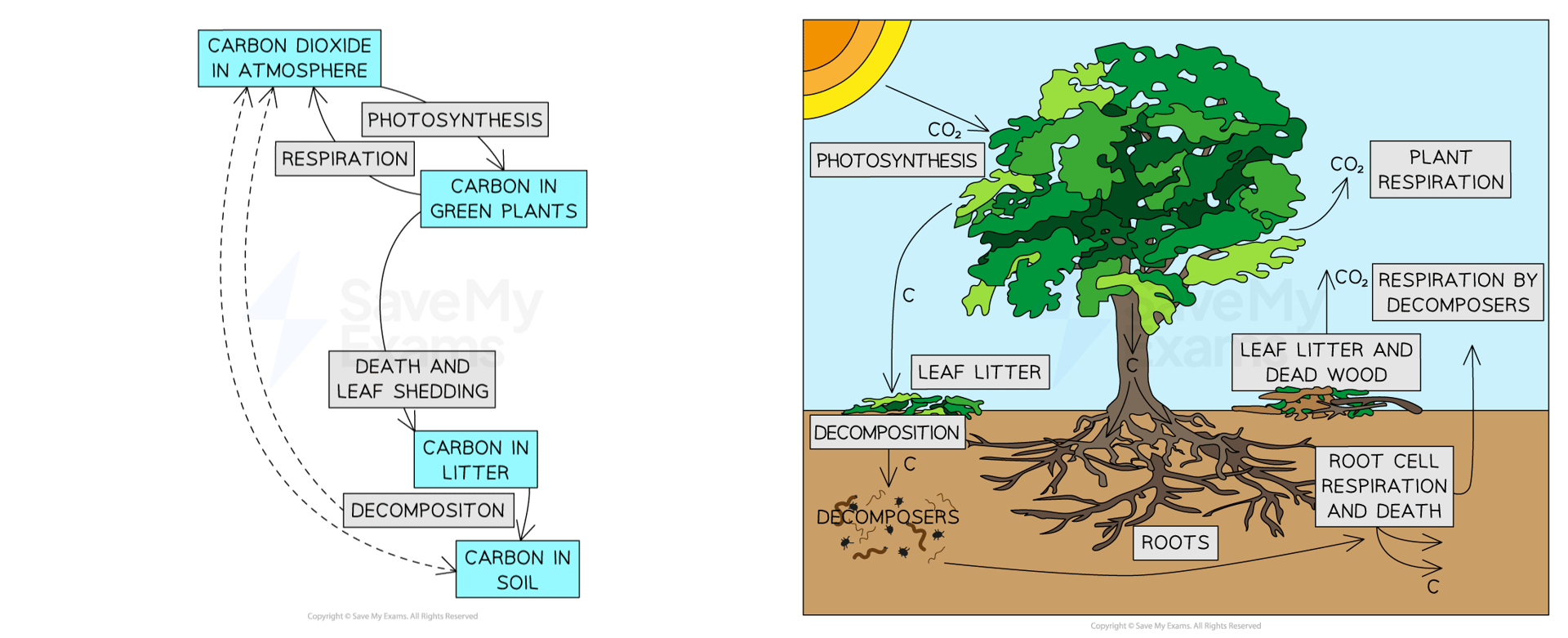Phytoplankton & Sequesteration of Carbon
Sequestration of Carbon
- Sequestering is the movement of carbon into carbon stores which can lower the amount of carbon dioxide in the atmosphere
- Photosynthesis (by land based plants and phytoplankton) is the main process responsible for sequestering carbon from the atmosphere
Ocean Sequestration
- 93% of carbon dioxide is stored in undersea algae, plants, coral and dissolved form, making oceans the largest carbon store on Earth
- The movement of carbon within oceans is controlled:
- Vertically by carbon cycle pumps
- Horizontally by thermohaline circulation
- There are three carbon cycle pumps which move carbon dioxide to the sea floor and to the ocean surface to be released into the atmosphere
- Biological pump
- The biological cycle sequesters carbon in the ocean through photosynthesis by phytoplankton and other marine animals which converts CO2 into organic matter (10GtC per year)
- This acts as a biological pump transporting carbon from the oceans' surface to the intermediate and deep ocean stores (10 GtC per year)
- As the biological organisms die, their dead cells, shells and other parts sink into the mid and deep water
- Also, the decay of these organisms releases carbon dioxide into the intermediate and deep water stores
- Oceans regulate the composition of the atmosphere by moving carbon from the ocean’s surface (where it may vent back into the atmosphere) and storing it in the mid and deep ocean store, along with the dissolved carbon store, which regulates the carbon cycle
- Carbonate pump
- Relies on inorganic carbon sedimentation
- When organisms die and starts to sink, many shells dissolve before they reach the ocean floor entering the deep ocean currents
- The solubility cycle occurs when CO2, absorbed by the oceans from the atmosphere, forms carbonic acid which in turn reacts with hydrogen ions to form bicarbonates and then further reactions form carbonates which are stored in the upper ocean
- Some organisms use these carbonates to make their shells or skeletons
- When these organisms die some material sinks to the ocean floor and forms the sea bed sediment store (1750 GtC)
- Over time, through chemical and physical processes, the carbon is transformed into rocks such as limestone
- This process locks up carbon in the long-term carbon cycle and does not allow an easy return to the ocean surface and so prevents possible venting into the atmosphere as the physical pump does
- Physical pump
- Considered the most important transfer
- Carbon dioxide (CO2) is absorbed by the ocean's surface through diffusion
- Dissolved CO2 is then taken from the surface down to the intermediate and deep ocean stores through downwelling currents (96 GtC per year)
- The thermohaline circulation then distributes the carbon around the planet
- Cold water absorbs more CO2, therefore, as the equatorial waters move toward the poles, more CO2 is absorbed
- Salinity increases at the same time, making the water denser, therefore, the water sinks (downwelling) taking CO2 from the ocean's surface to the deep ocean stores
- Allowing more diffusion to occur at the surface and helping to regulate the carbon stored in the atmosphere
- However, there is also the upwelling of carbon from intermediate and deep oceans to the surface oceans (105.6 GtC yr-1)
- Through upwelling currents and turbulence created by surface winds, previously stored carbon in the intermediate and deep ocean stores, return to the ocean’s surface and then back into the atmosphere
- Biological pump

- The thermohaline circulation is a global system of surface and deep ocean currents driven by differences in temperature and salinity
- These ocean currents are responsible for circulating carbon
- Warm surface waters are depleted of nutrients and carbon dioxide through evaporation but they become enriched again through the circulation of currents
- Also, the circulation helps move carbon in the carbonate pump from the surface to deeper waters

Thermohaline Circulation
Exam Tip
Ocean Sequestering is a particularly difficult concept to understand. Be sure to revise the three carbon cycle pumps (biological, physical and carbonate) and the thermohaline circulation


